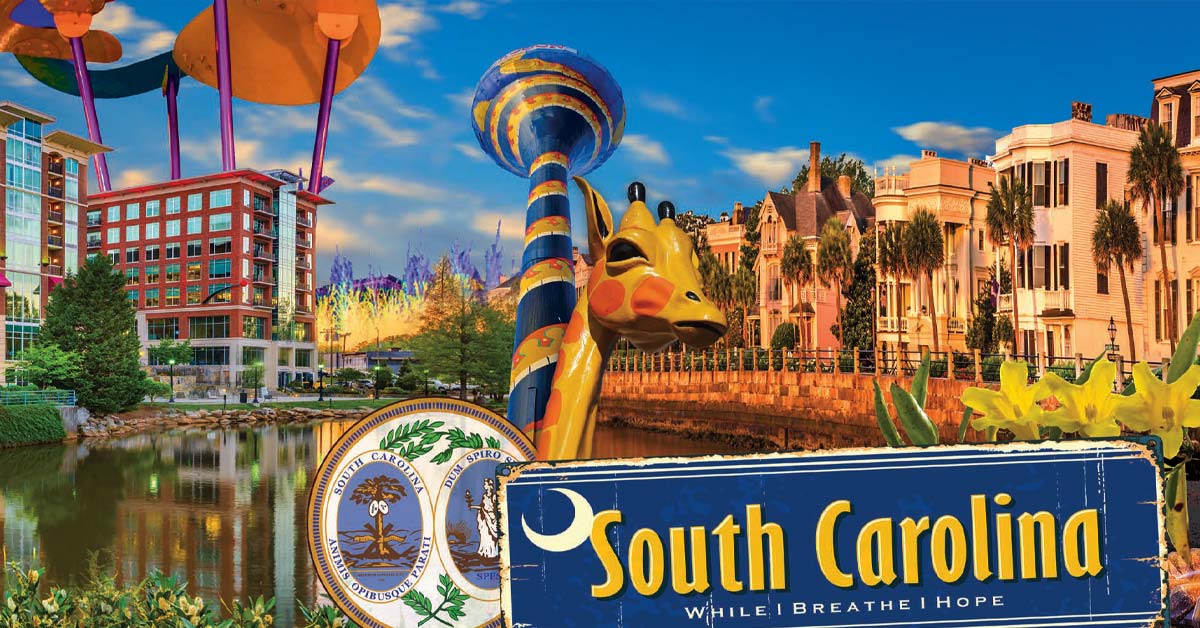South Carolina’s economy shifted into high gear in 2017, driven by an influx of large manufacturers and numerous suppliers, according to the state’s Department of Employment and Workforce. South Carolina’s gross domestic product (GDP) was $219.1 billion in 2017, which ranked 26th in the nation.
The state also has seen solid population growth of late. South Carolina was the nation’s 23rd most populous state to begin 2019 with an estimated 5.2 million residents, according to the World Population Review. The state’s growth rate since 2010 ranked 18th in the country.
South Carolina’s job picture has improved dramatically. The Palmetto State’s unemployment rate approached 12 percent in early 2010 but has steadily declined before hitting a low of 3.2 percent in August 2018. The unemployment rate as of this past February was below the national average, but wages still lag behind the U.S. as a whole. Federal data suggests that South Carolina’s per capita personal income in 2017 was $40,421, or about 80 percent of the U.S. average.
The Palmetto State ranked No. 42 on the 2018 Best States list from U.S. News & World Report. South Carolina ranked among the bottom half of states for health care, education, opportunity, infrastructure, crime and corrections, and quality of life.
Several of South Carolina’s major cities, however, have seen strong local GDP growth, led by the Greenville, Columbia and Charleston-North Charleston metro areas, The Post and Courier reported. Greenville has had the state’s largest economy in recent years, with a GDP of more than $35 billion in 2016, according to the U.S. Bureau of Economic Analysis. Greenville is home to numerous manufacturers, such as Michelin North America Inc. and aerospace and defense contractor Lockheed Martin.
The state’s fastest-growing economy, however, has been in the old port city of Charleston, which has been repeatedly named as one of the best cities in the world to visit and draws millions of tourists each year. Studies suggest that as many as 28 new people per day have been moving into the Charleston metro area, Colliers International reported.
Charleston’s growth has been driven by a surge in manufacturing jobs. Boeing opened a plant in 2011 to build 787 Dreamliner passenger jets. Volvo Cars recently began producing vehicles at a $1 billion campus in nearby Ridgeville, and Mercedes-Benz Vans opened a $500 million assembly plant in North Charleston.
Charleston office market
Several new office buildings have opened in Charleston since 2017, pushing up vacancy rates and putting pressure on rents, according to Colliers International. The overall market vacancy rate rose in first-quarter 2019 to 13.7 percent, up 1.6 percentage points compared to first-quarter 2018. Asking rents were up 2.6 percent year over year to $24.38 annually per square foot, but rents remain lower than the 2017 peak.
A total of 14 office buildings totaling some 780,000 square feet were under construction in the past first quarter. Colliers predicted that it would take a few quarters for the demand to catch up with this new supply. There were 110 office leases executed in Charleston in the past first quarter, as well as 31 sales transactions, according to CoStar.
Focus: Agriculture
South Carolina’s economy was traditionally driven by agriculture, and the state still has about 25,000 farms that encompass 4.9 million acres, according to the South Carolina Department of Agriculture (SCDA). The state’s top 10 commodities are broilers (chicken), turkeys, greenhouse nurseries, cotton, corn, cattle, soybeans, peanuts, eggs and wheat, according to SCDA. Agriculture’s annual production is worth about $3 billion.
The state also lies within the Virginia-Carolina tobacco belt. Although tobacco production has been waning, South Carolina farmers still produced an estimated 22.1 million pounds of tobacco in 2018, ranking it sixth among U.S. states for tobacco production, according to Statista. In 2017, the state assembly approved a pilot program enabling farmers to grow industrial hemp. Last year, it offered permits to 40 farmers for each to grow as many as 20 acres of the crop, which doubled to 40 acres this year.
Unemployment
South Carolina’s unemployment rate stood at 3.2 percent as of this past February, or 60 basis points lower than the national average for the same month, according to the U.S. Bureau of Labor Statistics. The Palmetto State’s rate was stable for seven straight months at that time.
The state’s median wage has run behind the national average, however. In 2017, the state’s median wage was $50,570, which lagged behind the U.S. median by $9,766, according to U.S. Census Bureau data. The median wage had risen nearly 7.9 percent in the three years through 2017, which also was less than the 8.5 percent growth in the U.S. median wage during the same three-year period.
What the locals say
“The [Charleston] commercial real estate sector turned around in early 2010. I firmly believe that was because Boeing announced in 2009 that they were going to be moving a production line for 787s. That really was the shot in the arm that we needed coming out of the recession, quite frankly. They announced that they were going to employ 3,000 employees [initially]. It’s like 12,000 employees now. Then Conde Nast named Charleston the No. 1 city in the world to visit, and we got that designation probably two or three years in a row. Some other magazines picked up on that, and really it just kind of snowballed.”
Edward Oswald
President, Charleston Trident Association of Realtors
3 Cities to Watch
Charleston
Founded in 1670 and located at the midpoint of South Carolina’s coastline, Charleston is the oldest city in the state. The first battle of the Civil War was fired in Charleston Harbor, when Gen. P.G.T Beauregard bombarded the Union-held Fort Sumter. The city’s population was estimated in 2017 at about 134,000, and 550,000 people live in the greater metro area. The Milken Institute this past January ranked the Charleston region’s economy as the 16th best in the nation, due largely to new investments by the automotive industry, The Post and Courier reported.
Columbia
Located near the center of the state, Columbia is the state capital and second-largest city with an estimated population of about 133,000 as of 2017, according to census figures. Forbes ranked the Columbia metro area No. 93 in the nation for business and careers, noting that it is home to two large military installations and several colleges, including the main campus of the University of South Carolina. Columbia is home to an eclectic shopping area in the Five Points neighborhood, as well as the popular Finlay Park.
Sumter
Originally incorporated in 1845, Sumter is named after Gen. Thomas Sumter, the “Fighting Gamecock” of the Revolutionary War. Sumter’s population today is about 40,000, according to the World Population Review. The city is home to several colleges and Shaw Air Force Base. Many buildings in the original commercial district date from 1880 to 1912 and are constructed of tin, limestone and brick materials typical of the 19th century, according to the South Carolina Department of Archives and History.
Sources: City of Charleston, Colliers International, CoStar, Forbes, South Carolina Department of Archives and History, Statista, The Post and Courier, The State, Upstate Business Journal, U.S. Bureau of Economic Analysis, U.S. Census Bureau, U.S. Department of Labor, U.S. News & World Report, World Population Review
Author
-

Victor Whitman is a contributing writer for Scotsman Guide and a former editor of the publication’s commercial magazine.
View all posts






